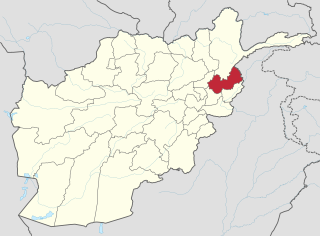Related Research Articles

The Indo-Aryan languages are a branch of the Indo-Iranian languages in the Indo-European language family. As of the early 21st century, they have more than 800 million speakers, primarily concentrated in India, Pakistan, Sri Lanka, Bangladesh, Nepal and Maldives. Moreover, apart from the Indian subcontinent, large immigrant and expatriate Indo-Aryan–speaking communities live in Northwestern Europe, Western Asia, North America, the Caribbean, Southeast Africa, Polynesia and Australia, along with several million speakers of Romani languages primarily concentrated in Southeastern Europe. There are over 200 known Indo-Aryan languages.

Pakistan is a multilingual country with dozens of languages spoken as first languages. The majority of Pakistan's languages belong to the Indo-Iranian group of the Indo-European language family.

Gāndhārī is a Prakrit language found mainly in texts dated between the 3rd century BCE and 4th century CE in the region of Gandhāra, located in the northwestern Indian subcontinent. The language was heavily used by the former Buddhist cultures of Central Asia and has been found as far away as eastern China, in inscriptions at Luoyang and Anyang.

The Nuristani languages, also known as Kafiri languages, are one of the three groups within the Indo-Iranian language family, alongside the much larger Indo-Aryan and Iranian groups. They have approximately 130,000 speakers primarily in eastern Afghanistan and a few adjacent valleys in Khyber Pakhtunkhwa's Chitral District, Pakistan. The region inhabited by the Nuristanis is located in the southern Hindu Kush mountains, and is drained by the Alingar River in the west, the Pech River in the center, and the Landai Sin and Kunar rivers in the east. The languages were previously often grouped with Indo-Aryan or Iranian until they were finally classified as forming a third branch in Indo-Iranian.

The Dardic languages, or Hindu-Kush Indo-Aryan languages, are a group of several Indo-Aryan languages spoken in northern Pakistan, northwestern India and parts of northeastern Afghanistan.
Âṣkuňu is a language of Afghanistan spoken by the Ashkun people – also known as the Âṣkun, Ashkun, Askina, Saňu, Sainu, Yeshkun, Wamas, or Grâmsaňâ – from the region of the central Pech Valley around Wâmâ and in some eastern tributary valleys of the upper Alingar River in Afghanistan's Nuristan Province. Other major places where the language of Ashkun is spoken are Nuristan Province, Pech Valley in Wama District, eastern side of the Lower Alingar Valley in Nurgaram and Duab districts, Malil wa Mushfa, Titin, Kolatan and Bajagal valleys.

Khowar, or Chitrali, is an Indo-Aryan language primarily spoken in Chitral and surrounding areas in Pakistan.

Shina is an Indo-Aryan language spoken by the Shina people. In Pakistan, Shina is the major language in Gilgit-Baltistan spoken by an estimated 1,146,000 people living mainly in Gilgit-Baltistan and Kohistan. A small community of Shina speakers is also found in India, in the Guraiz valley of Jammu and Kashmir and in Dras valley of Ladakh. Outliers of Shina language such as Brokskat are found in Ladakh, Kundal Shahi in Azad Kashmir, Palula and Sawi in Chitral, Ushojo in the Swat Valley and Kalkoti in Dir.

Torwali is an Indo-Aryan language mainly spoken in the Bahrain and Chail areas of the Swat District in Pakistan. The language and other non-Pashtun communities are often referred to as "Kohistani" which is a name given by the Swat Pashtuns. Fredrik Barth says "The Pathans call them, and all other Muhammadans of Indian descent in the Hindu Kush valleys, Kohistanis". The Torwali language is said to have originated from the pre-Muslim communities of Swat. It is the closest modern Indo-Aryan language still spoken today to Niya, a dialect of Gāndhārī, a Middle Indo-Aryan language spoken in the ancient region of Gandhara.
Gawri (ګاوری), also known as Kalami (کالامي), or Bashkarik, is an Indo-Aryan language spoken in Swat Kohistan region in the upper Swat District and in the upper Panjkora river valley of Upper Dir District, Khyber Pakhtunkhwa, Pakistan.

The Brokpa, sometimes referred to as Minaro, are a small ethnic group mostly found in the union territory of Ladakh, India around the villages of Dha and Hanu. Some of the community are also located across the Line of Control in Baltistan in the villages around Ganokh. They speak an Indo-Aryan language called Brokskat. The Brokpa are mostly Vajrayana Buddhist while some are Muslim.

Indus Kohistani is an Indo-Aryan language spoken in the former Kohistan District of Pakistan. The language was referred to as Maiyã (Mayon) or Shuthun by early researchers, but subsequent observations have not verified that these names are known locally.
Tirahi were the speakers of the Tirahi language, a nearly extinct if not already extinct Indo-Aryan language which may still be spoken by older adults, who are likewise fluent in Pashto, in a few villages in the southeast of Jalalabad in Nangarhar Province, Afghanistan. They were the previous inhabitants of Tirah and the Peshawar Valley in modern-day Khyber Pakhtunkhwa, Pakistan.
Brokskat or Minaro is an endangered Indo-Aryan language spoken by the Brokpa people in the lower Indus Valley of Ladakh and its surrounding areas. It is the oldest surviving member of the ancient Dardic language. It is considered a divergent variety of Shina, but it is not mutually intelligible with the other dialects of Shina. It is only spoken by 2858 people in Ladakh and 400 people in the adjoining Baltistan, part of Pakistan-administered Kashmir.
Sawi, Savi, or Sauji, is an endangered Indo-Aryan language spoken in northeastern Afghanistan and north-western Pakistan. It is classified as a member of the Shina language cluster within the Dardic subgroup.

Khetrānī, or Khetranki, is an Indo-Aryan language of north-eastern Balochistan. It is spoken by the majority of the Khetrans, a Baloch tribe that occupies a hilly tract in the Sulaiman Mountains comprising the whole of Barkhan District as well as small parts of neighbouring Kohlu District to the south-west, and Musakhel District to the north. The ethnic Khetran population found to the east in the Vehova Tehsil of Taunsa Sharif District of Punjab instead speak Saraiki. Alternative names for the language attested at the start of the 20th century are Barāzai and Jāfaraki.

South Asia is home to several hundred languages, spanning the countries of Afghanistan, Bangladesh, Bhutan, India, Maldives, Nepal, Pakistan, and Sri Lanka. It is home to the third most spoken language in the world, Hindi–Urdu; and the sixth most spoken language, Bengali. The languages in the region mostly comprise Indo-Iranic and Dravidian languages, and further members of other language families like Austroasiatic, Turkic, and Tibeto-Burman languages.
The Torwali people are an Indo-Aryan ethnolinguistic group located in the Swat district of Pakistan. The Torwali people have a culture that values the telling of folktales and music that is played using the sitar. They speak an Indo-Aryan language called Torwali.
The Inner–Outer hypothesis of the subclassification of the Indo-Aryan language family argues for a division of the family into two groups, an Inner core and an Outer periphery, evidenced by shared traits of the languages falling into one of the two groups. Proponents of the theory generally believe the distinction to be the result of gradual migrations of Indo-Aryan speakers into India, with the inner languages representing a second wave of migration speaking a different dialect of Old Indo-Aryan, overtaking the first-wave speakers in the center and relegating them to the outer region.

Brokpa, Drokpa, Dard and Shin is a category of Scheduled Tribes under the Indian constitution.
References
- 1 2 3 Tirahi at Ethnologue (15th ed., 2005)

- ↑ "Tirahi". Ethnologue. Retrieved 2016-04-27.
It is very likely that this language is extinct. The Tirahi are "a group of unclear origin, almost completely assimilated by Pashtun" (Pstrusinska and Gray 1990).
- ↑ Prakāśaṃ, Vennelakaṇṭi (2008-01-01). Encyclopaedia of the Linguistic Sciences: Issues and Theories. Allied Publishers. p. 143. ISBN 9788184242799.
- ↑ Konow, Sten (1933). Acta Orientalia, Volumes 11-12. Munksgaard. p. 161.
- 1 2 Turner, R. L. (1934-01-01). "Review of Report on a Linguistic Mission to North-Western India". Journal of the Royal Asiatic Society of Great Britain and Ireland. 66 (4): 801–803. doi:10.1017/S0035869X00112675. JSTOR 25201006.
- 1 2 Voegelin, C.F.; Voegelin, F.M. (1965). "Languages of the World: Indo-European Fascicle One". Anthropological Linguistics. 7: 286.
- ↑ Stein, Aurel (Jul 1925). "Notes on Tirahi. The Speakers of Tirahi". The Journal of the Royal Asiatic Society of Great Britain and Ireland. 3: 401–402.
- 1 2 3 4 Grierson, George (March 1925). "On The Tirahi Language". The Journal of the Royal Asiatic Society of Great Britain and Ireland (3): 408. JSTOR 25220761.
- ↑ Grierson, G. (1925). On the Tirahi language. Journal of the Royal Asiatic Society (New Series), 57(03), 405-416.
- ↑ Jain, Dhanesh; Cardona, George (2003-01-01). The Indo-Aryan Languages. Routledge. p. 857. ISBN 9780700711307.
- ↑ Jain, Dhanesh; Cardona, George (2003-01-01). The Indo-Aryan Languages. Routledge. pp. 857–9, also for all grammatical information below. ISBN 9780700711307.